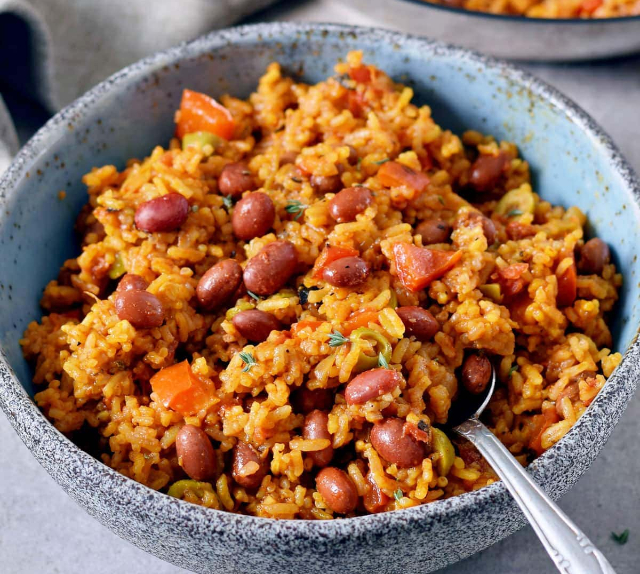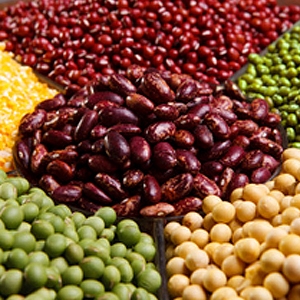I often hear this one from folks who’ve decided to at least try turning away from meat and animal proteins. Fortunately, Healthline.com provides a comprehensive guide on what to eat and (avoid) going veggie…
 Peppy Spanish Beans and Rice: beautiful colours, bold flavours – ultimately up to you!
Peppy Spanish Beans and Rice: beautiful colours, bold flavours – ultimately up to you!
And a perfect balance of nutrients for the veggie-vegan diner. So full of
umami goodness, you’d never know it didin’t have meat!
Most folks don’t take into account how complex it can be to establish and maintain a proper nutritional balance when going vegetarian or – even tougher – vegan.
The huge health reference website Healhline.com has help. In fact, it has an encyclopedic article organized in a number of sections addressing the major issues folks leaving animal proteins behind need to know.
The big question
Before folks take the leap, they need to know what their vegetarian diet style options are. And there are many… Healthline makes it easy to differentiate between the main ones to determine what veggie sub-community you belong in:’
The most common types include:
- Lacto-ovo-vegetarian diet: Eliminates meat, fish and poultry but allows eggs and dairy products.
- Lacto-vegetarian diet: Eliminates meat, fish, poultry and eggs but allows dairy products.
- Ovo-vegetarian diet: Eliminates meat, fish, poultry and dairy products but allows eggs.
- Pescetarian diet: Eliminates meat and poultry but allows fish and sometimes eggs and dairy products.
- Vegan diet: Eliminates meat, fish, poultry, eggs and dairy products, as well as other animal-derived products, such as honey.
- Flexitarian diet: A mostly vegetarian diet that incorporates occasional meat, fish or poultry.
And there are more, with more being proposed by veggie advocates almost daily. It’s good to choose one, though, and stick with it. Your body will thank you once it’s settled into your chosen new eating pattern.
Downsides
While veggie fans usually don’t go out of their way to address this issue, there are some potentially serious drawbacks to dropping animal proteins from your diet:
“A well-rounded vegetarian diet can be healthy and nutritious,” Healthline assures. “However, it may also increase your risk of certain nutritional deficiencies.”
The good news is, that’s what supplements are made for…
“Including a variety of fruits, vegetables, whole grains, protein sources and fortified foods is an easy way to ensure you’re getting appropriate nutrition. […] Multivitamins and supplements are another option to quickly bump up your intake and compensate for potential deficiencies.”
As you progress on your vegetarian adventure, you’ll just naturally become aware of potential downsides, and do your own homework to find solutions that suit your personal needs and tastes.
The part you’ve been waiting for
Healthline conveniently provides a well-curated list of foods you’ll want to try as part of your premiere forays into veggetarian dining:
A few healthy foods to consider on a vegetarian diet include:
- Fruits: Apples, bananas, berries, oranges, melons, pears, peaches
- Vegetables: Leafy greens, asparagus, broccoli, tomatoes, carrots
- Grains: Quinoa, barley, buckwheat, rice, oats
- Legumes: Lentils, beans, peas, chickpeas.
- Nuts: Almonds, walnuts, cashews, chestnuts
- Seeds: Flaxseeds, chia and hemp seeds
- Healthy fats: Olive oil, avocados
- Proteins: Tempeh, tofu, seitan, natto, nutritional yeast, spirulina, eggs, dairy products
They keys to the the Vegetarian Kingdom…
Not unlike other diets, the overall keys to staying healthy – and even thriving – when you switch to a vegetarian diet are:
- Including a diverse mix of fruits, vegetables, grains, healthy fats and proteins.
- Replacing the protein provided by meat in your diet must include a variety of protein-rich plant foods like nuts, seeds, legumes, tempeh, tofu and seitan.
- Eating nutrient-dense whole foods like fruits, vegetables and whole grains will supply a range of important vitamins and minerals to fill in any nutritional gaps in your diet.
It’s up to you
The foregoing should provide you with everything you need top know to decide whether you you’re cut out to be a veggie by choice. I emphasize ‘by choice’, since we’ll all be relying heavily if not exclusively on vegetarian diets by 2050 – maybe be even sooner – for the bulk of our sustenance as animal proteins price themselves out of our budgets or are phased out to help fight climate change.
Remember: the plant-protein substitutes and alternatives to animal proteins being touted as the great saviours of meal-lovers’ palates and the ultimate way to segue from meat to veggies have always been intended as bridging products at best. And to the frustration of meat lovers and manufacturers alike, many of them haven’t been competitive with the price point of conventional meat. Nor have the products themselves turned out as satisfying and tasty as hoped.
Which brings us to something I’ve said all along: In the end, it’ll be be just you and me and the veggies ‘as they are’. Best, I think, to get used to veggies and appreciate them for themselves, from the outset. Rather than having to adjust again a decade or so down the road…
~ Maggie J.

